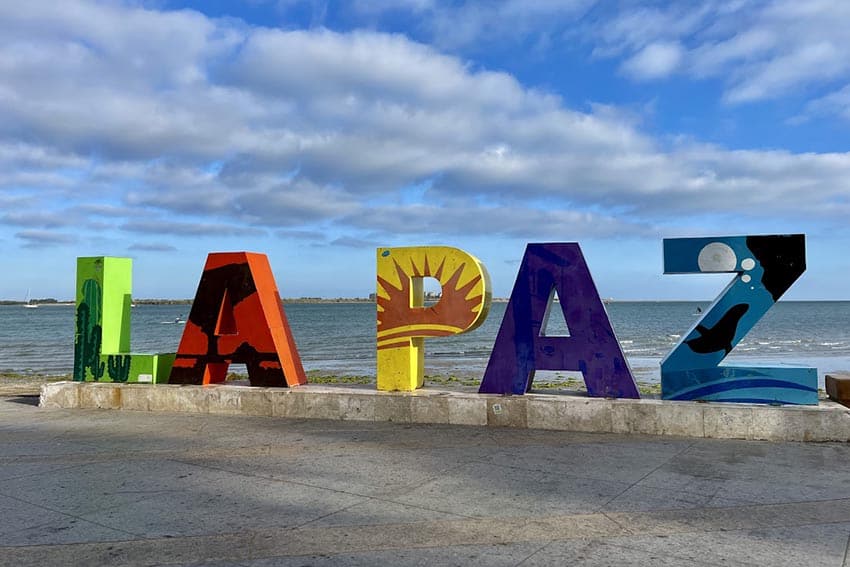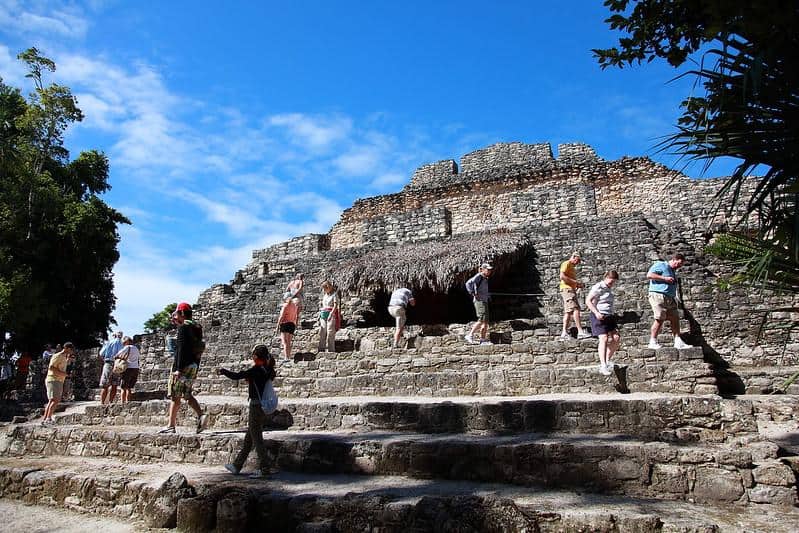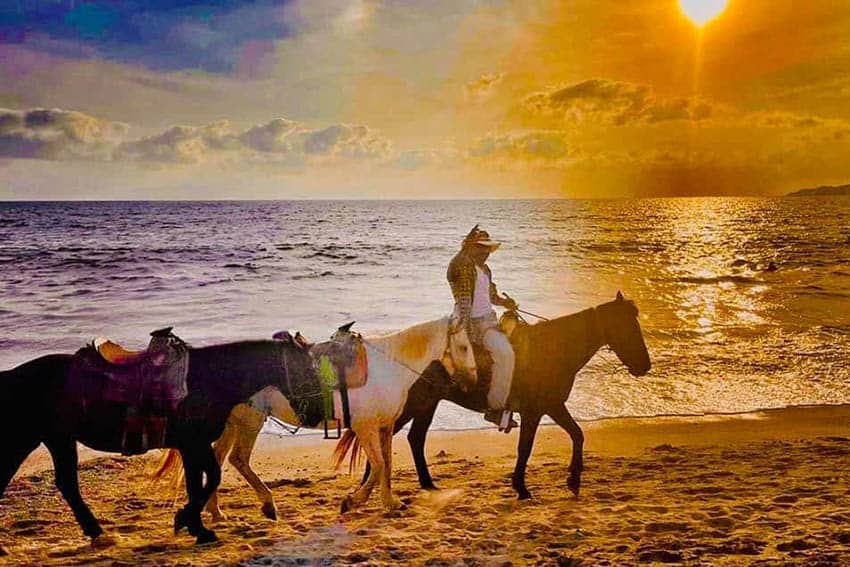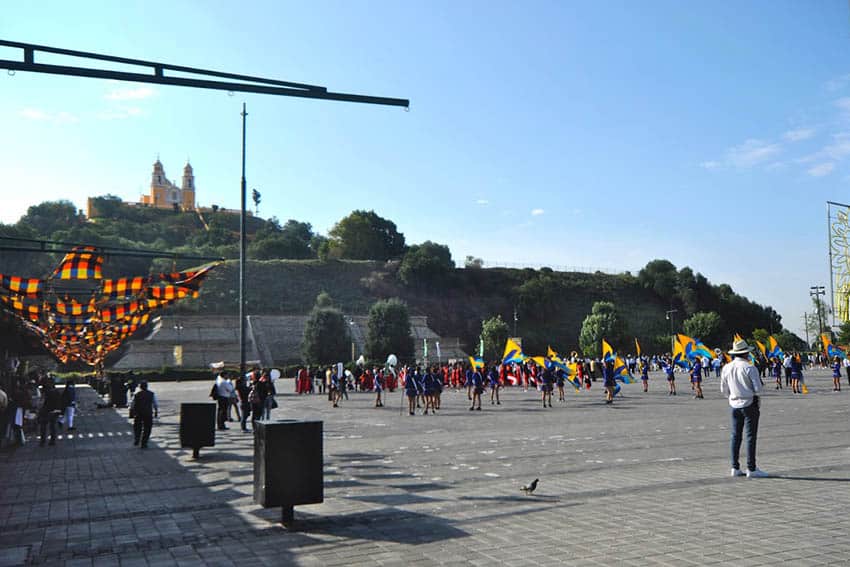
Cholula is centuries of History in the Shadow of a Volcano
By Bryanna Plog
The state of Puebla, Mexico is hilly country. Crusty hills covered in sunbaked scrub roll out in all directions as you drive the dusty 105D
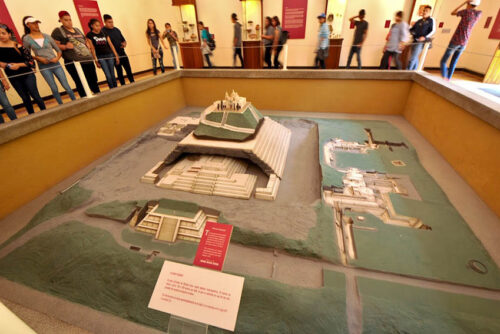
and 190 highways southeast from Mexico City. The land is punctuated by cacti and rattling fields of maize, with flat-topped cinder cones popping out of the plains like pimples.
In the distance are rows of steep mountains, including the perfect cone of Popocatépetl and the jagged mass of Iztaccíhuatl, volcanoes that rise in the west to heights of over 17,000 feet.
Tectonic Forces
Massive tectonic forces create rows of hills and chains of volcanoes in the central Mexican highlands of the Cordillera Neovolcánica and the region sits at over 6,500 feet of elevation.
I headed to the pueblo of Cholula, in Puebla, hoping to leave the smog of Mexico City behind and get views of the surrounding countryside and its volcanoes, especially Popocatépetl, which was experiencing a small eruption while I was there.
Located just west of the large city of Puebla, Cholula was supposed to be a quiet, pleasant place where I could sit at the edge of the zólaco, the city plaza, and eat mole poblano, the spiced chile, chocolate, and nut sauce the region was famous for.
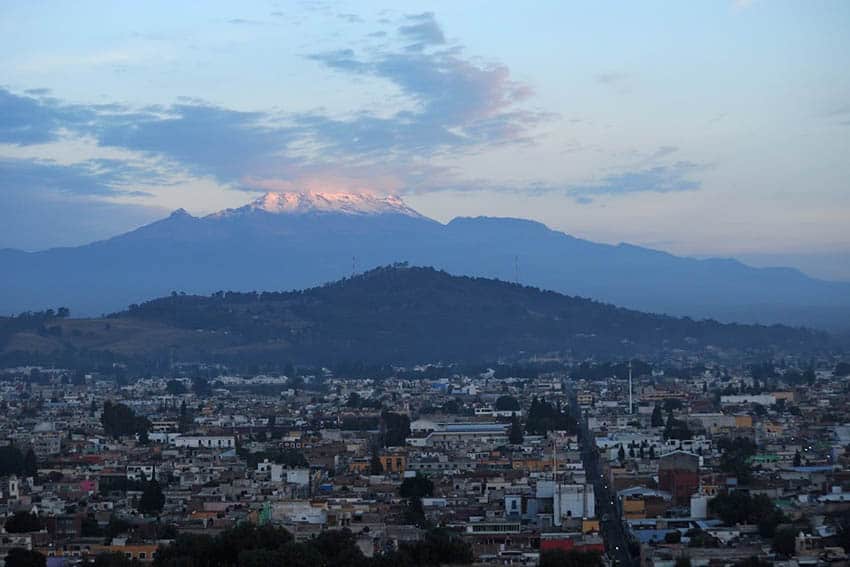
I learned that Cholula has its own very prominent hill whose origin story is quite different from the mountains looming in the distance.
Tlachihualtépetl, the “man-made mountain”
Cholula’s cerrito, the “little hill,” is known locally as Tlachihualtépetl and is mostly tree-covered except for a prominent church on the top. “Tlachihualtépetl” is a Nahuatl word.
The dialects of Nahuatl, one of 63 indigenous languages spoken in Mexico, are the language of the Aztecs still spoken by around two million people, and where we get such words as chocolate, avocado, chile, and coyote, in addition to “mescal,” “tequila,” and “Mexico.” I learned Iztaccíhuatl means “white woman,” and Popocatépetl means “smoking mountain.”
Tlachihualtépetl means “man-made mountain.” Cholula’s little hill has a very different origin story than the volcanoes looming in the distance.
Tlachihualtépetl, also known widely in Spanish as la gran pirámide de Cholula, and in English as the Great Pyramid of Cholula, is an human-made construction, a pyramid so hidden under the plants and dirt of millennia that it was not re-discovered as a massive pyramid until 1910.
Many Mesoamerican cultures such as the Maya and Aztec built pyramids which still stand in what is today Mexico, Guatemala, and other parts of Central America. But the largest of all these pyramids is Tlachihualtépetl/the Great Pyramid of Cholula, sometimes known further as Tepanapa, built by a people known as the Choluteca starting sometime around 300 BC.
With an estimated height of almost 200 feet and a base around 1,300 feet, it is the largest pyramid in the world by volume. Bigger than the Luxor Hotel in Las Vegas, bigger than the Pyramid of the Sun in Teotihuacán, bigger than the pyramids of ancient Egypt.
The sense of massive scale of the Great Pyramid of Khufu might benefit from rising straight out of the flat desert, but its base is a fourth of the size and the largest Egyptian pyramids are about half the volume of Tlachihualtépetl.
I stood on a concrete sidewalk in the deepening heat of highland Mexico and tried to take in the pyramid from street level. I could see how it had been hidden in plain sight for so long: time had rounded its original step-shape and it was now covered in withered brown grass and leafy trees, rising above brightly painted apartments, storefronts with hand-painted signs, and church spires.
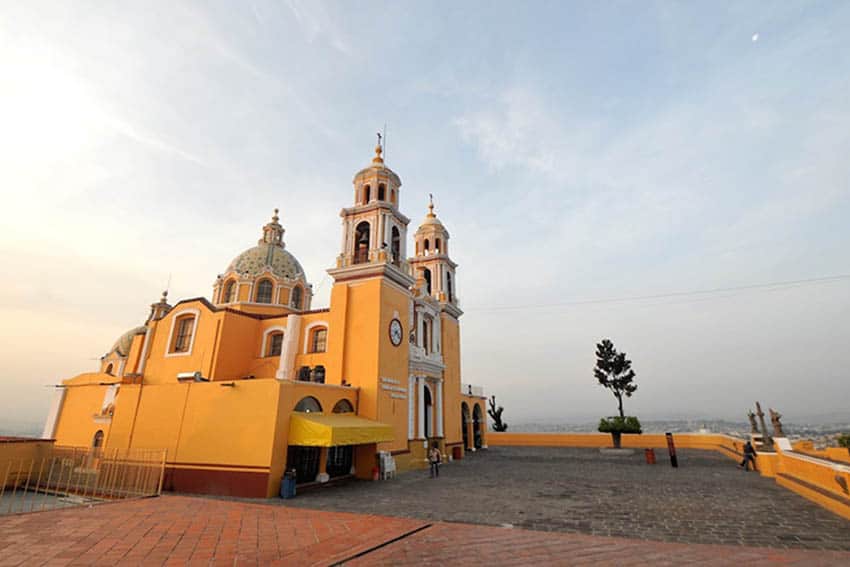
A 15th century church, Santuario de la Virgen de los Remedios (Sanctuary of the Virgin of Remedies) caps the top of the hill, its crisp yellow walls, bright dome, and double spires visible from every part of Cholula.
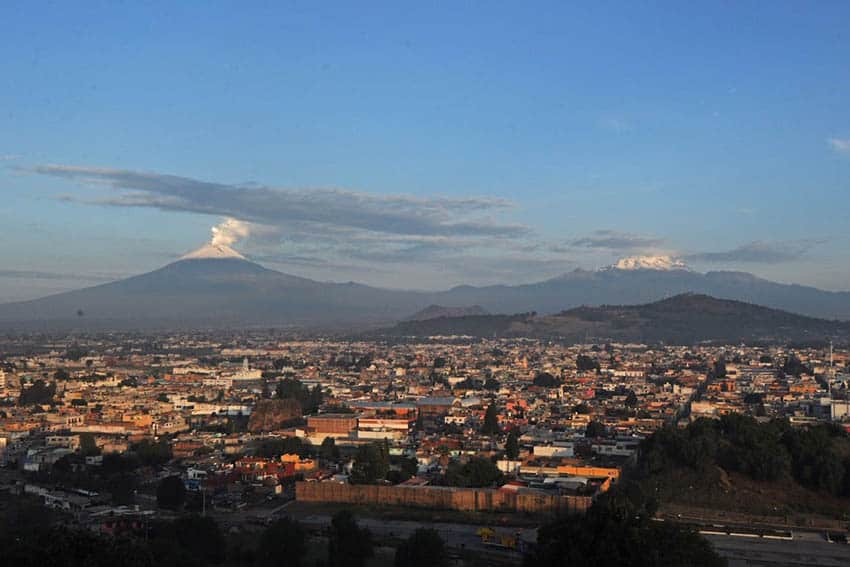
On Top of the Pyramid: A View of Volcanoes
I climbed the steep but short walkway to the top of the pyramid almost every evening and morning I was in Cholula, joining locals jogging or carrying hand weights as they strode purposefully up the pedestrian road. The top beyond the courtyard of the church was a public park, with families running around, lovers stretched out in the grass, and other tourists taking pictures of the view.
And the views delivered. Popocatépetl was casually letting off a thick plume of steam the whole time I was there, and the last morning, both it and Iztaccíhuatl were painted a dazzling white by fresh snow at their very tops. The city of Cholula, mostly two story buildings punctured by numerous church spires, stretched out until disappearing into fields of prickly pear cacti and distant blue hills.
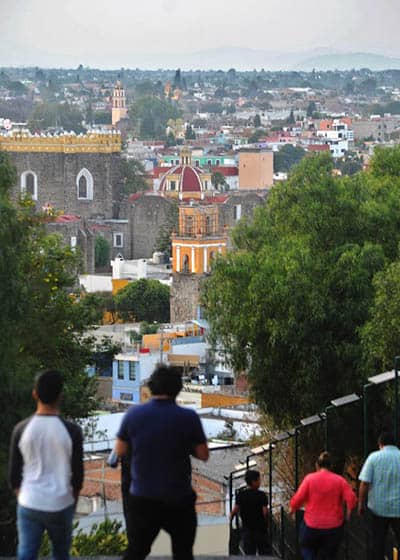
Twitter of Birds, Sounds of Dogs
I sat and listened to the constant twitter of birds in the trees, mixing with the sounds of dogs barking and cars in the city below. A repeating couple bars of a trumpet melody could have been some advertisement jingle down in the city or someone practicing trumpet in their house, I couldn’t be sure.
My first night there, I kept hearing the distant blasts of fireworks, celebrations for the Fiesta de la Santa Cruz.
I chatted with a woman selling postcards in front of the yellow-orange walls of the Santuario de la Virgen de los Remedios, standing next to a sandwich board advertising ice cream bars and with a view of Popocatépetl framed between a carved stone cross and two carved angels facing the mountains.
We talked about how lucky I had been with the weather, as the rainy season was starting, and how people would ask “¿dónde está el volcán?” during the many days of fog and haze in the area.
“Ayer no se veo. Antier tampoco,” she said. They couldn’t see the volcanoes the days before. “Now, the miracle is how beautiful it is to look at it. But not every day.” I was struck by the many ways the hills of Cholula could be hidden.
The postcard seller tried to get me to pronounce Popocatépetl (“poh-poh-kah-TEH-peh-til”) and Iztaccíhuatl (“e-sta-SI-wha-til”) properly, the names rolling off her tongue as only those growing up with Nahuatl words could do and she laughed pleasantly at my efforts. After a bit, we just concentrated back on the view.
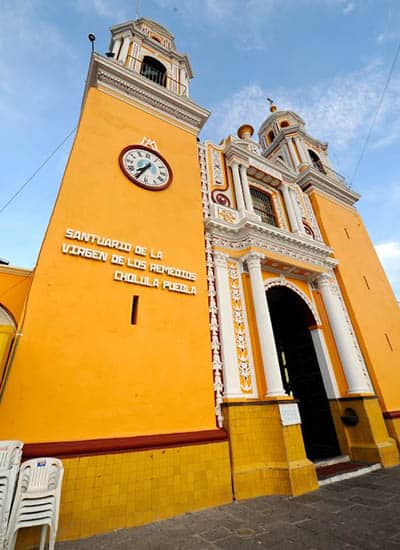
Thanks to those ancient Cholulans, there we were on this hill/not-a-hill with the countryside laid out below us.
Ancient Cholula
We know very little about the people of ancient Cholula or why they built a pyramid. There have been human remains found at one of the corners of the pyramid, but it doesn’t seem to be strictly a tomb, as the pyramids at Giza were.
The pyramid was part of Cholula’s religious center of some kind, certainly, situated in such a way (oriented with the sun during the summer solstice), that it might point to the importance of a sun god.
Cholula remained a religious center for well over a thousand years, but the role the pyramid played in this is unknown.
A Public Works Project
The pyramid was a public works project spanning generations. At least four distinct periods of building kept expanding it, fitting new architectural styles—and new pyramids—over the older ones, usually featuring stairs for people to climb to the top.
The pyramids are mostly built with adobe bricks, the clay and mud building blocks that are mixed straw and sand and dried in the sun, though limestone and stucco were used as well.
By around AD 800, a thousand years after it was started, no more changes were made to the Great Pyramid. The Choluteca civilization changed, was conquered, or spread out to neighboring regions (no one really knows), and the pyramid slowly took on the shape of natural mountains around the region, even as descendants of the Choluteca lived among other, much smaller pyramids in the town.

There were always people in Cholula—making it also the oldest continuously inhabited city in Mexico, and perhaps the Americas—but the local knowledge of the pyramid began to be lost. Lichen, then moss, then grass grew in the cracks of the adobe bricks, then soil formed and trees and shrubs began to grow.
By the time Hernán Cortés arrived a thousand years later in 1519 with plans to conquer for Queen, God, and Greed, it was completely transformed into a hill. Upon arriving in Cholula, Cortés and his men promptly massacred between 3,000 and 6,000 people, then destroyed other small pyramids still in the city and in 1574 started to build a church on top of Tlachihualtépetl, never knowing the layers of history hidden beneath layers of grass and soil. The pyramid, and the church on top, both still stand today.
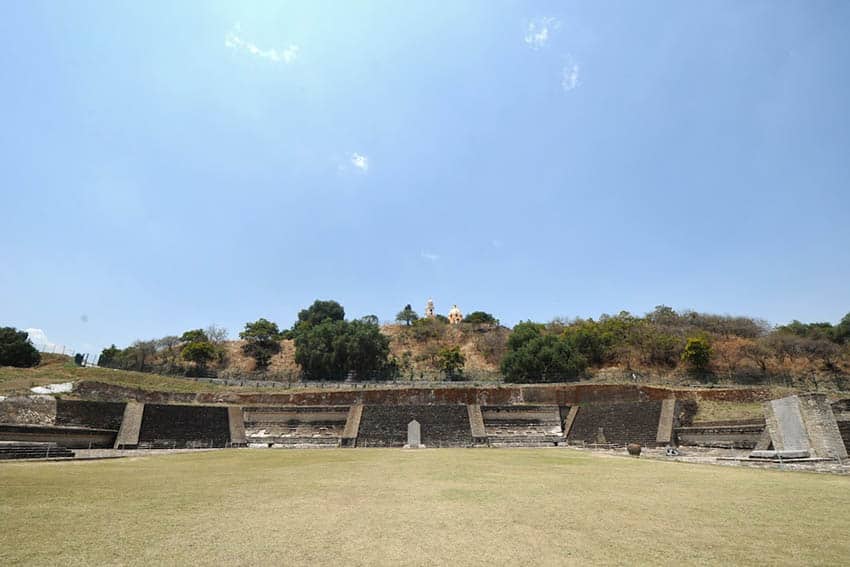
It would take until 1910, as the story goes, when an insane asylum was being built, that artifacts and walls were discovered, though the hill’s name must have meant that locals knew there was something unnatural about the hill.
According to signs at the small museum today near the pyramid—itself on the site of the old insane asylum—formal exploration of the pyramid started in 1931, where over the next two decades architects and archaeologists tunneled into the pyramid.
When I visited, some of those tunnels were open for the public to explore.

Inside the Pyramid
I paid 70 peso for entrance to the museum and tunnels. It was a quiet day and no guide was needed so I plunged into the dim tunnels with no other human beings in sight. Instantly the outside noise of the city was muted.
The walls changed appearance as I walked through different layers of the pyramids, but the rectangular adobe bricks were evident throughout as I slowly made my way through the construction. I ran my hand over a few stones, rough to the touch, first carved by hand one thousand or two thousand years ago. I had brought my headlamp and shone it up in caverns that ended abruptly and down passageways that resembled water channels.
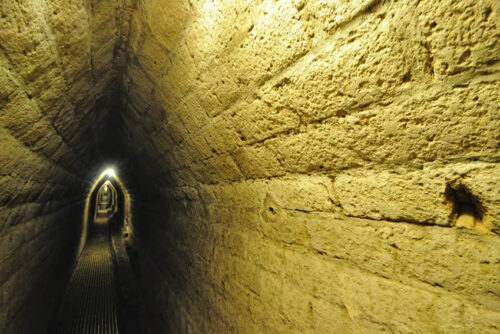
Built just tall enough that I didn’t have to duck with my short frame, about a half mile of tunnels are open to the public, now lit by electric lights and with an entrance and exit that made sure everyone was walking on a one-way route.
It would have been difficult to pass people in the narrow space. Not surprisingly, the tunnels were musty and gloriously cool compared to the radiating heat outside.
Emerging into the Bright Light
It was a shock to emerge into the bright sub-tropical sun again as the tunnel exited at the south edge of the pyramid, in one part of the Zona Arqueológica that reminds the visitor that the ancient city of Cholula was more than one pyramid.
A few outlying buildings and walls are now excavated and I wandered past the cut rock walls and sides of the pyramid.
Outbuildings, steep trenches, stone altars, and faded murals, including one depicting people drinking as part of sacred ritual, have all been excavated as part of what was the bustling religious center of Cholula.
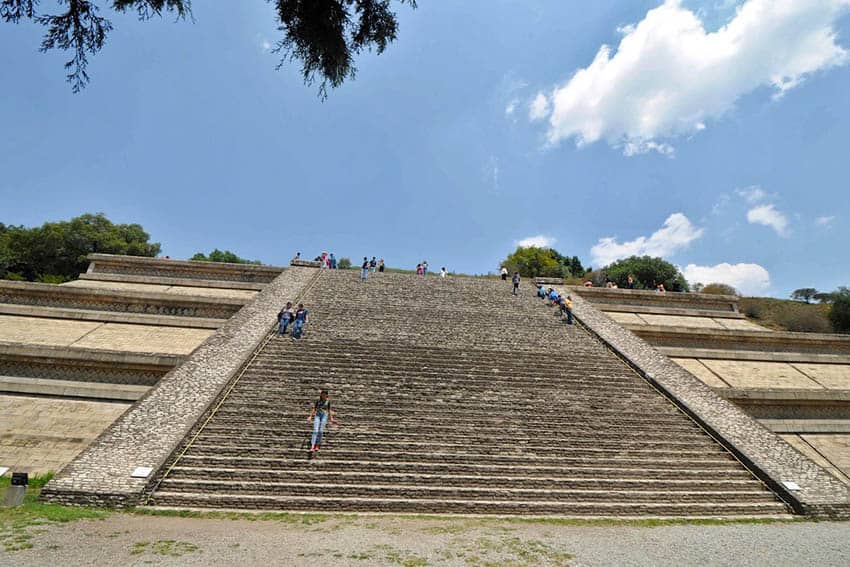
Back near the western side of the hill was the most popular spot for photos, a sloping series of steps on one side of the pyramid that you could climb, as long as you were careful with your footing.
Built on the original pyramid, it was reconstructed to show what the side of the pyramid might have looked like. Finally I could start to picture what it might have looked like two thousand years ago.
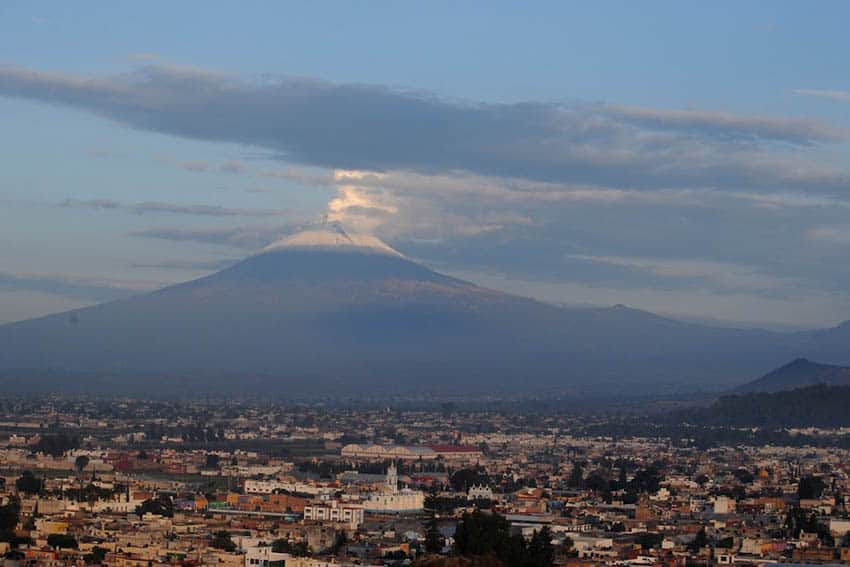
Into the Modern World

Other sides of the pyramid have been sacrificed by the Mexican government to try and draw in more tourists. Despite the protests of some locals and archaeologists who worry about destroying priceless pre-Columbian structures, and a curious lack of oversight by the
INAH (National Institute of Anthropology and History), a new train station was built to link the big city of Puebla to Cholula and a massive square at the base of the pyramid was paved over, now with a series of souvenir shops at one end.
Why the Great Pyramid of Cholula was built may never be able to be fully answered. Perhaps that it was built at all is what we should glorify. What lengths we humans go to create our own tlachihualtépetl, our own man-made mountains.
On my last morning, as I walked down from the Santuario de la Virgen de los Remedios for the last time, I passed from church to public park to pre-Hispanic structure to the natural world, Popocatépetl and Iztaccíhuatl going in and out of view.
I couldn’t tell where the 2,300 year old pyramid ended and where the Earth’s topography began.

- These 9 U.S. National Parks Require Reservations in 2024 - April 17, 2024
- Take a Hike in Olympic National Park - April 17, 2024
- The Wild Mississippi: 2340 Miles Across Ten States - April 8, 2024


